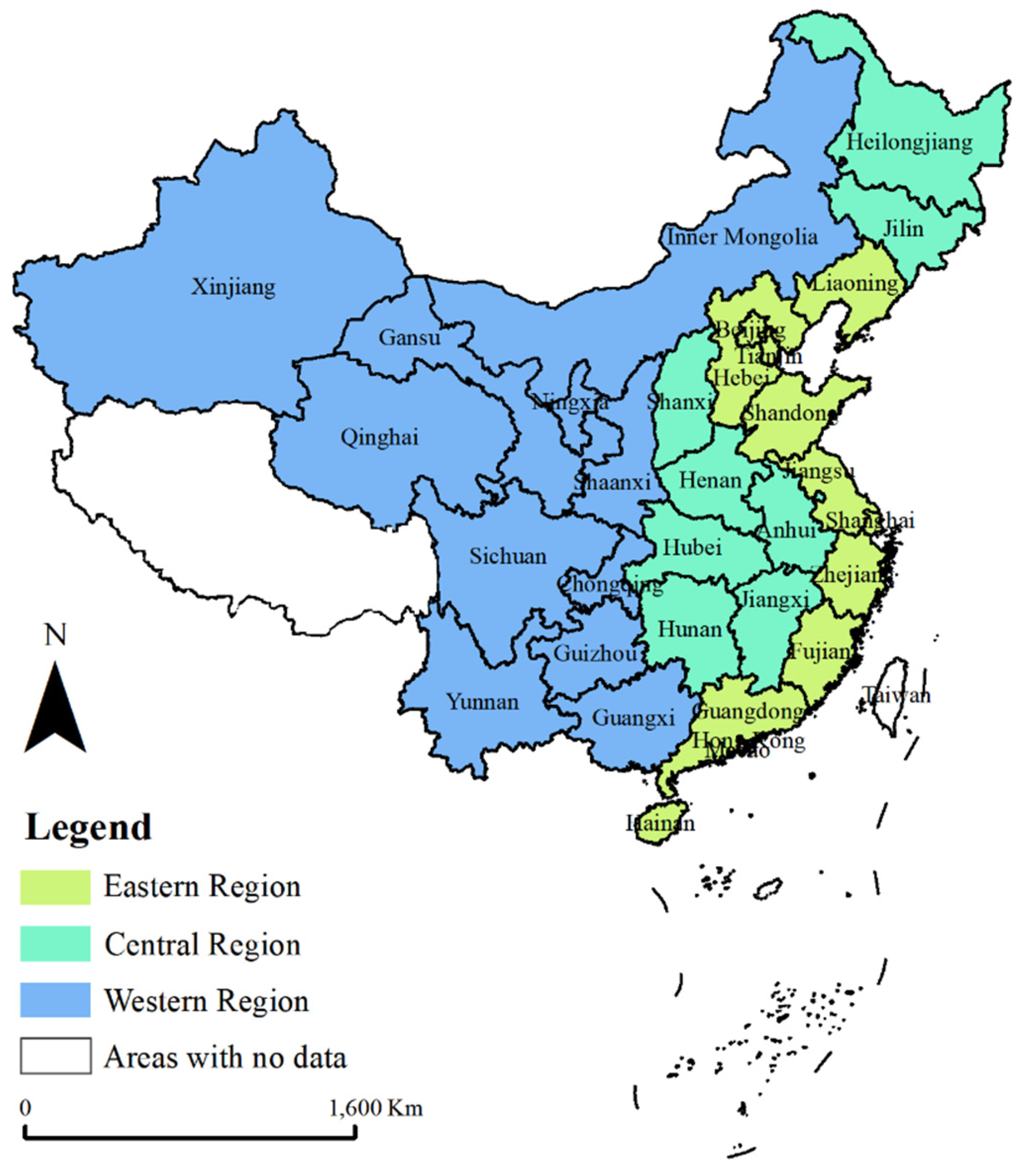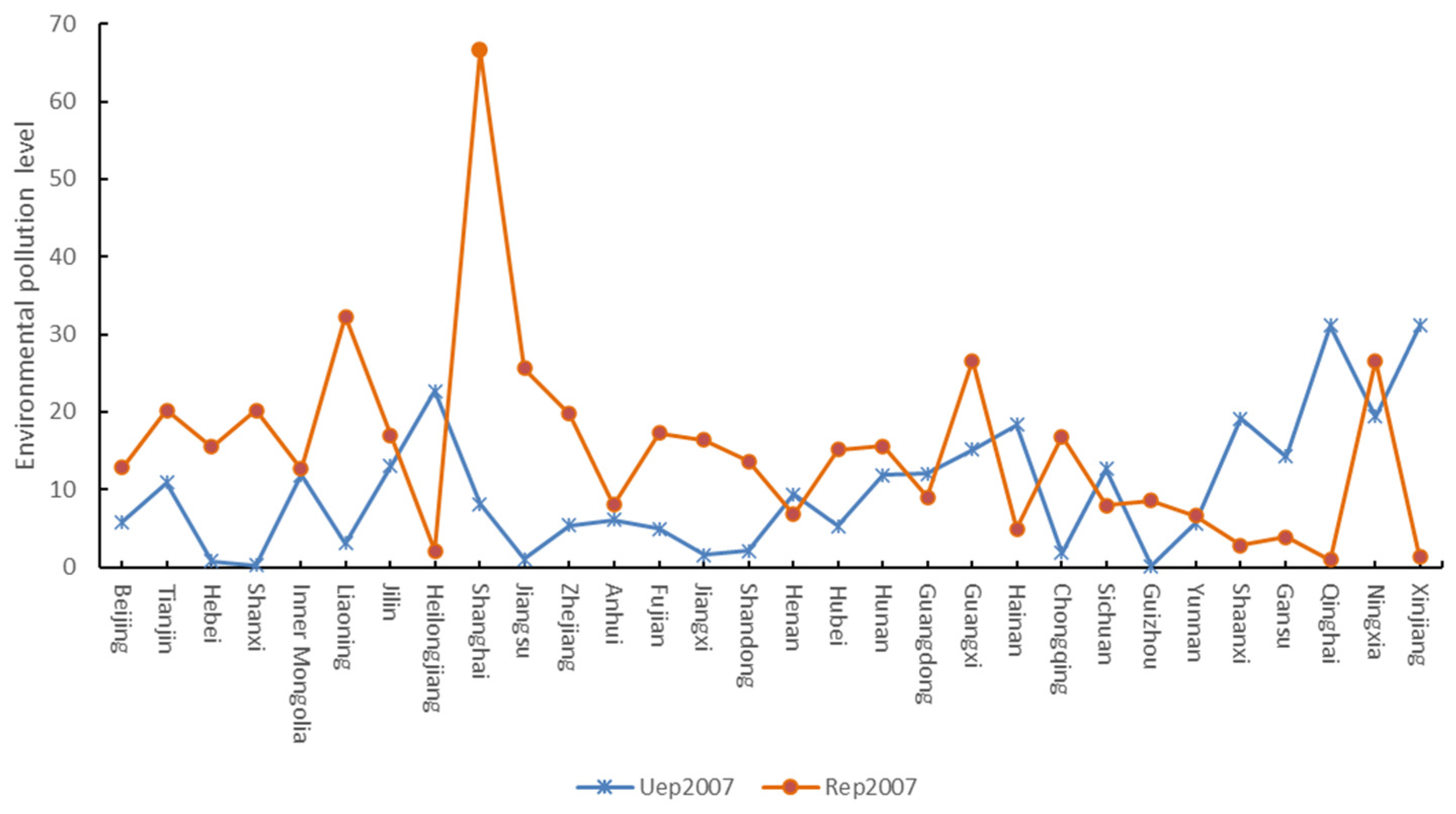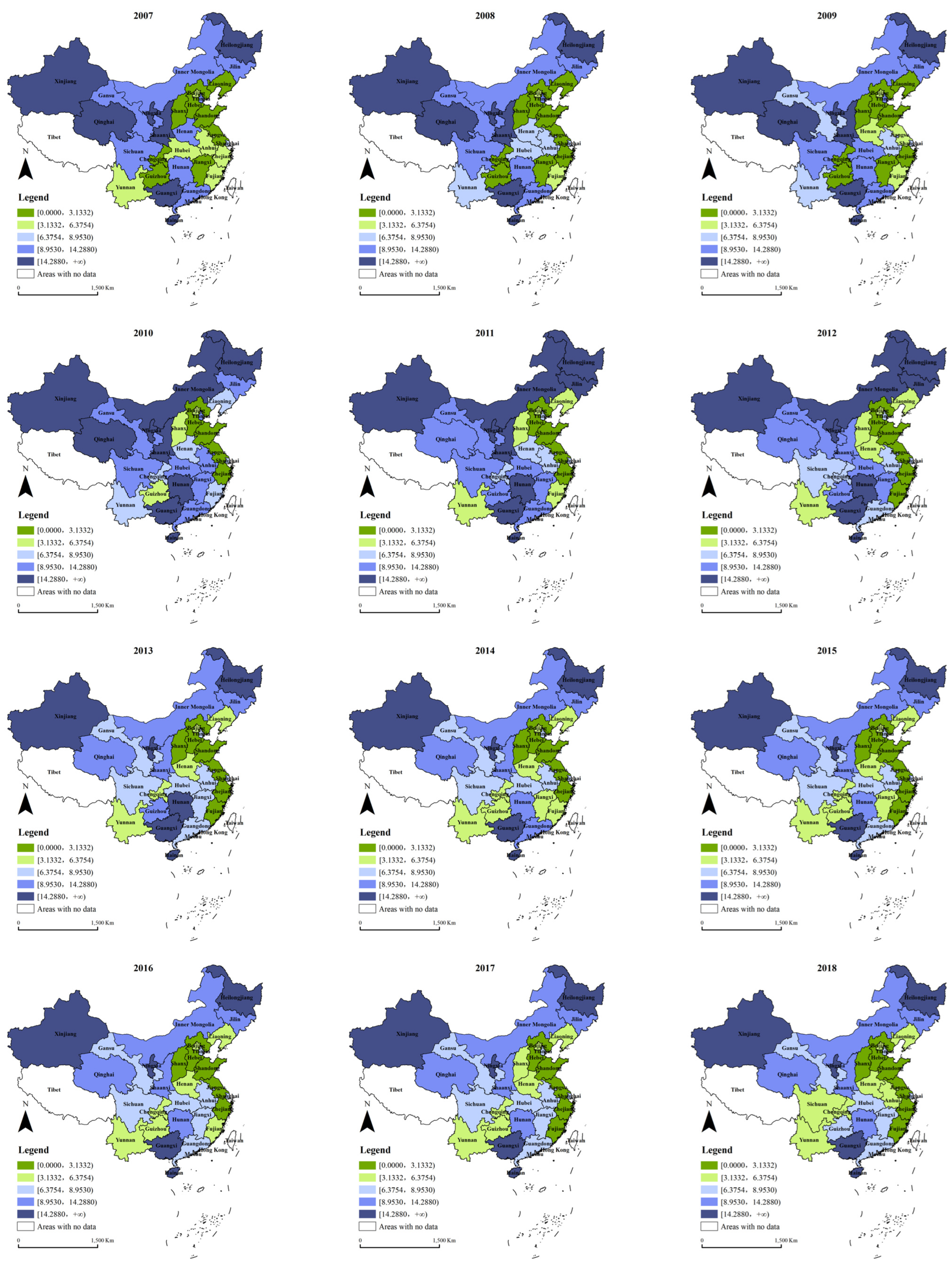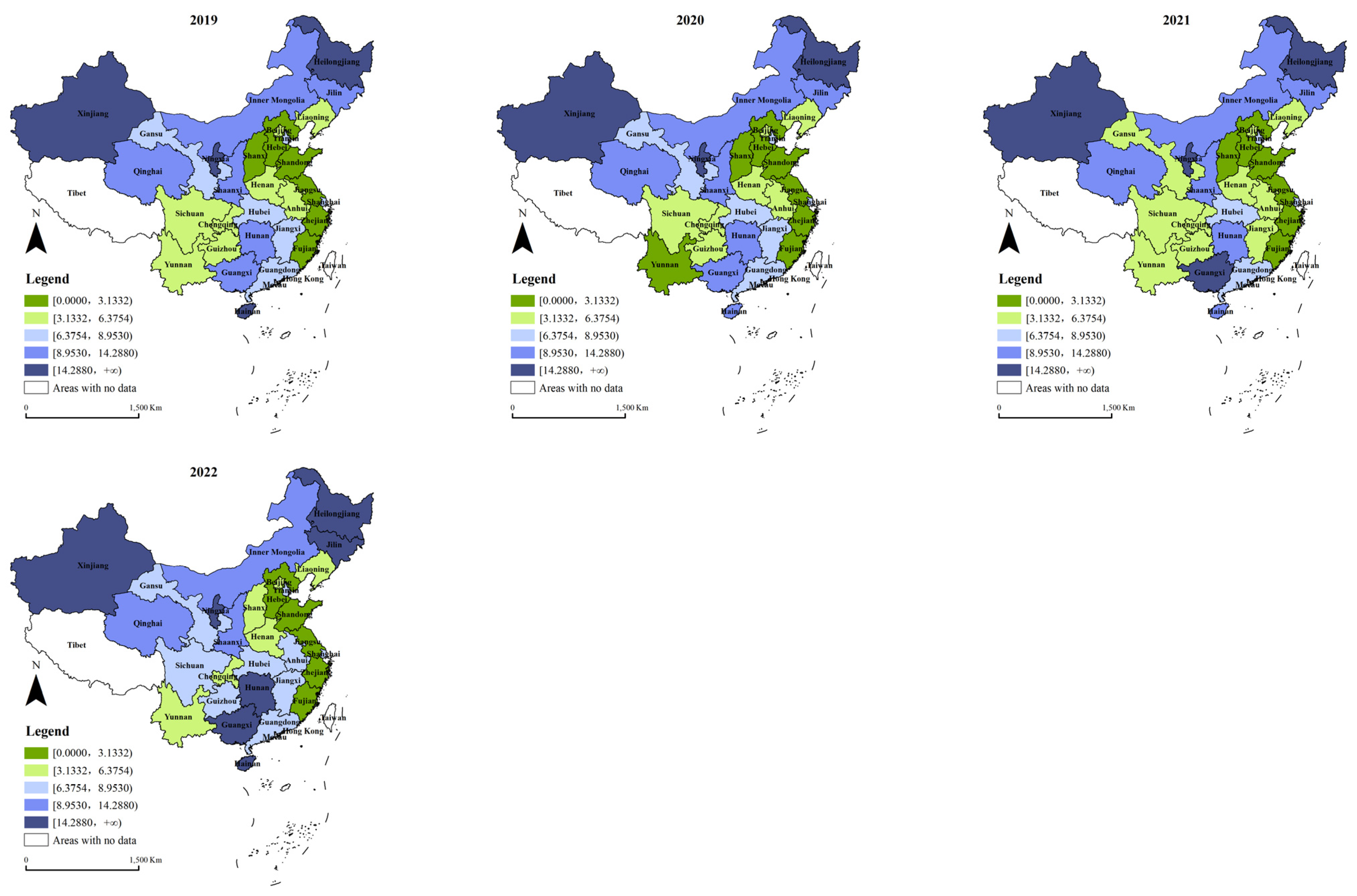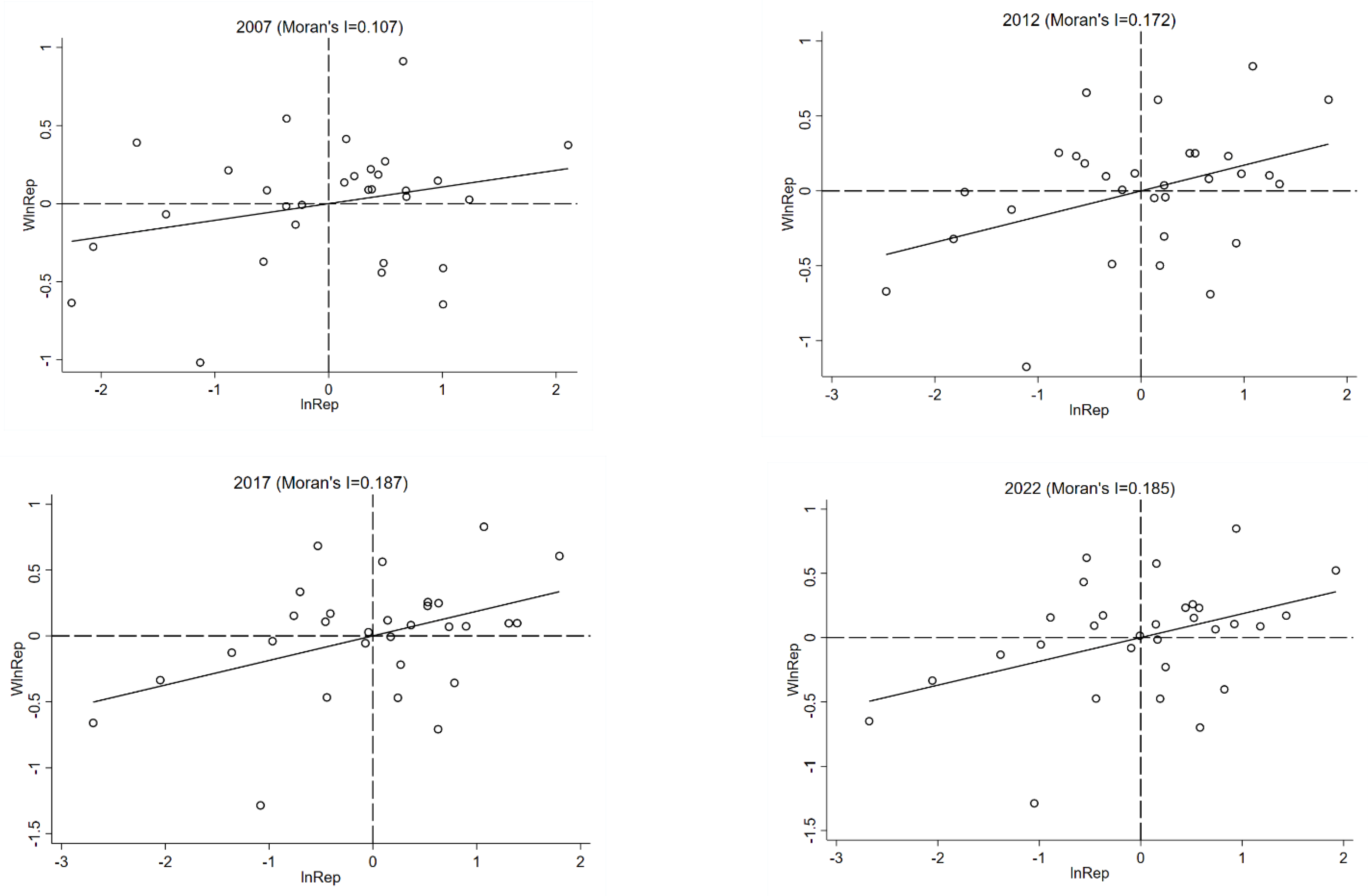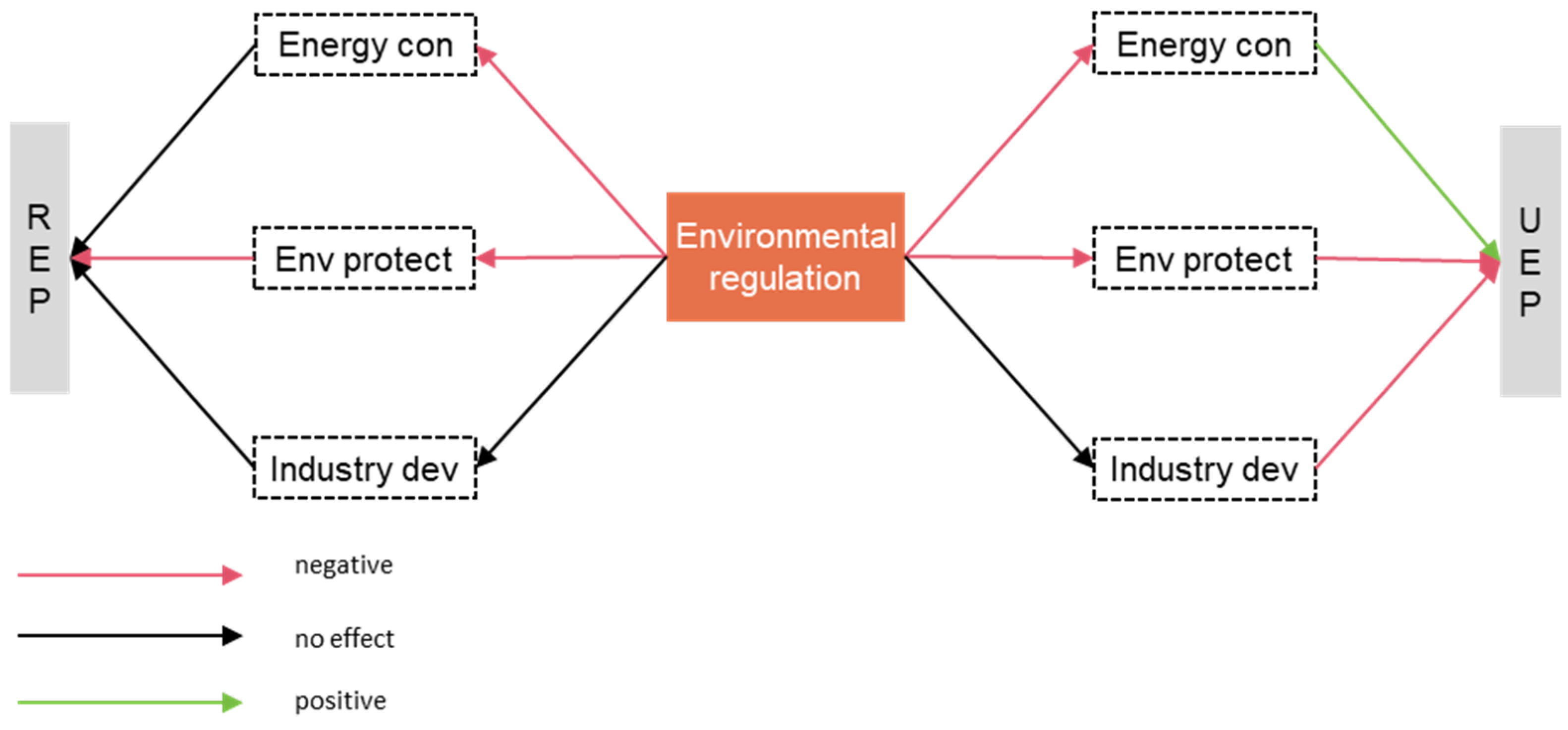3.1. Spatial and Temporal Distribution of Urban and Rural Environmental Pollution
The average urban environmental pollution over the period from 2007 to 2022 stands at 9.0892. This value transitioned from 10.1574 in 2007 to 8.9540 in 2022, indicating an improvement over time. This metric serves as a foundational reference point for assessing the overarching trend in urban pollution levels (
Figure 3).
Notably, 2010 stands out with the highest average pollution level at 11.6105, suggesting potentially elevated pollution during that year. Conversely, 2021 exhibits the lowest average pollution level at 7.6702, indicating a potential improvement or mitigation of pollution issues.
Examining individual years, 2010, 2011, 2007, 2008, and 2012 emerge as years with relatively high levels of urban environmental pollution. The proportion of years where urban environmental pollution exceeds the mean is 43.75%, indicating that less than half of the years during this period had pollution levels above the average. Conversely, 56.25% of the years had pollution levels below the mean.
Conversely, 2021, 2020, 2019, 2018, and 2017 are identified as years with the smallest urban environmental pollution levels. This variability underscores the dynamic nature of urban pollution levels over time, with some years experiencing lower pollution levels compared to others.
Across the 30 provinces and municipalities studied, the average urban environmental pollution level aligns closely with the overall mean at 9.0892. Notably, Heilongjiang Province demonstrates the highest average pollution level, significantly exceeding the mean. Conversely, Hebei exhibits the lowest average pollution level among the provinces and municipalities studied.
Among the provinces and municipalities, Heilongjiang Province maintains the highest urban environmental pollution level, followed by Xinjiang, Guangxi, Ningxia, and Hainan. However, it is noteworthy that despite Heilongjiang’s high pollution level, the majority of provinces (63.33%) have mean values below the overall mean, indicating significant regional variation in pollution levels.
Conversely, Hebei stands out with the lowest urban environmental pollution level among the 30 provinces and municipalities, followed by Zhejiang, Jiangsu, Shandong, and Shanxi. These provinces may have implemented effective pollution control measures or possess favorable environmental conditions, contributing to their lower pollution levels compared to others.
From 2007 to 2022, the average level of rural environmental pollution stands at 14.8442, serving as a baseline for comprehending the broader trend in rural pollution levels. This value transitioned from 15.1123 in 2007 to 14.2675 in 2022, suggesting an improvement in performance over the specified timeframe. The year 2021 stands out with the highest average pollution level at 17.4535, indicating a potential peak in pollution during that year. Conversely, 2010 exhibits the lowest average pollution level at 11.7208, suggesting a relatively cleaner period (
Figure 4).
Examining individual years, 2021, 2020, 2019, 2018, and 2017 emerge as years with relatively high levels of rural environmental pollution. The proportion of years where rural environmental pollution exceeds the mean is 56.25%, indicating that more than half of the years during this period had pollution levels above the average. Conversely, 43.75% of the years had pollution levels below the mean.
Conversely, 2010, 2011, 2009, 2012, and 2022 are identified as years with the smallest rural environmental pollution levels. This variability underscores the dynamic nature of rural pollution levels over time, with some years experiencing lower pollution levels compared to others.
Across the 30 provinces and municipalities studied, the average rural environmental pollution level aligns closely with the overall mean, at 14.8442. Notably, Shanghai demonstrates the highest average pollution level, significantly exceeding the mean. Conversely, Qinghai exhibits the lowest average pollution level among the provinces and municipalities studied.
Among the provinces and municipalities, Shanghai maintains the highest rural environmental pollution level, followed by Liaoning, Jiangsu, Zhejiang, and Tianjin. However, it is important to note that despite Shanghai’s high pollution level, the majority of provinces (56.67%) have mean values below the overall mean, indicating significant regional variation in pollution levels.
Conversely, Qinghai stands out with the lowest rural environmental pollution level among the 30 provinces and municipalities, followed by Xinjiang, Shaanxi, Gansu, and Hainan. These provinces may have implemented effective pollution control measures or possess favorable environmental conditions, contributing to their lower pollution levels compared to others.
3.3. Relationship Between Environmental Regulation and Environmental Pollution (Urban and Rural)
The baseline regression results, as summarized in
Table 3, lead to the following main conclusions. Higher levels of urban and rural environmental pollution in the local area are associated with higher levels of urban and rural environmental pollution in neighboring areas. This is evident from the coefficient ρ, where the coefficients for urban pollution (ρ = 0.302***) and rural pollution (ρ = 0.286***) both indicate positive associations.
The spatial econometric regression results, as shown in columns (1) to (4) of
Table 3, reveal that the estimated coefficients (ρ) for the spatial lag terms of urban and rural environmental pollution are positive and statistically significant at the 1% level. This indicates that there exists a positive spatial correlation between urban and rural environmental pollution across different regions.
Moreover, it is important to note that spatial econometric models differ from traditional econometric models in that the regression coefficients no longer reflect the direct impact of independent variables on the dependent variable due to the presence of spatial effects. Instead, they serve as preliminary indicators of the effects of various variables. To explore the role of spatial effects further, the decomposition of spatial effects is conducted, as presented in
Table 4.
In terms of urban environmental pollution, the analysis reveals several noteworthy associations.
A decrease in the level of environmental regulation tends to lead to increased environmental pollution. In terms of the direct effect, a 1% increase in local environmental regulation results in a 1.245% increase in local environmental pollution (conversely, a 1% decrease in local environmental regulation leads to a 1.245% reduction in urban environmental pollution). This may be because when environmental regulation becomes less stringent, local enterprises in urban areas face fewer interventions and restrictions, allowing them greater flexibility and autonomy. As a result, while pursuing profits, these enterprises may also be more likely to reduce their negative impact on the environment.
In terms of the indirect effect, a 1% increase in environmental regulation in neighboring regions leads to a 1.844% increase in local urban environmental pollution (conversely, a 1% decrease in regulation in neighboring areas results in a 1.844% reduction in local urban pollution).
As for the total effect, a 1% increase in environmental regulation results in a 0.599% reduction in urban environmental pollution.
For each 1% increase in local transportation capacity, there is a concurrent 0.113% (0.113*) rise in local urban environmental pollution. However, the transportation capacity of neighboring areas shows no significant effect on local urban environmental pollution (0.194). Overall, a 1% increase in combined transportation capacity leads to a 0.307% (0.307**) rise in local urban environmental pollution. A 1% increase in local financial level corresponds to a substantial decrease of 4.806% (−4.806**) in local urban environmental pollution. Similarly, for every 1% increase in neighboring financial levels, there is a decrease of 15.755% (−15.755***) in local urban environmental pollution. Overall, a 1% increase in combined financial levels results in a remarkable decrease of 20.561% (−20.561***) in local urban environmental pollution.
An increase of 1% in local energy consumption intensity leads to a corresponding 0.172% rise (0.172*) in local urban environmental pollution. Conversely, for every 1% increase in neighboring energy consumption intensity, there is a significant decrease of 1.948% (−1.948***) in local urban environmental pollution. Overall, a 1% increase in combined energy consumption intensity results in a notable decrease of 1.776% (−1.776***) in local urban environmental pollution. With a 1% increase in local marketization level, there is a corresponding decrease of 0.809% (−0.809***) in local urban environmental pollution. However, a 1% increase in neighboring marketization levels leads to a contrasting increase of 1.265% (1.265**) in local urban environmental pollution. Notably, the marketization level of combined areas shows no discernible effect on local urban environmental pollution (0.456).
Local population size demonstrates a negative impact on local urban environmental pollution (−0.463***), indicating that as the population size increases, pollution tends to decrease. Conversely, neighboring population size does not significantly influence local urban environmental pollution (−0.434**). Overall, the population size of combined areas shows minimal impact on local urban environmental pollution (−0.030).
With local rural environmental regulation levels decreasing, local rural environmental pollution levels correspondingly increase. Similarly, a decrease in neighboring environmental regulation levels leads to a notable increase in local rural environmental pollution levels. Regarding transportation capacity, each 1% increase in local transportation capacity correlates with a decrease of 0.278% (−0.278***) in local rural environmental pollution. However, for rises in neighboring transportation capacity, there is a corresponding increase in neighboring rural environmental pollution.
Regarding financial factors, increases in local financial level are associated with a considerable aggravation in local rural environmental pollution. Conversely, for increases in neighboring financial levels, there is a notable improvement in local rural environmental pollution. However, the financial level of combined areas shows no significant effect on local rural environmental pollution. Energy consumption intensity also plays a role, with a 1% increase in local energy consumption intensity corresponding to a 0.230% increase in local rural environmental pollution. On the other hand, with increases in neighboring energy consumption intensity, there is a decrease in local rural environmental pollution. Moreover, increasing combined marketization levels leads to local rural environmental pollution increases.
